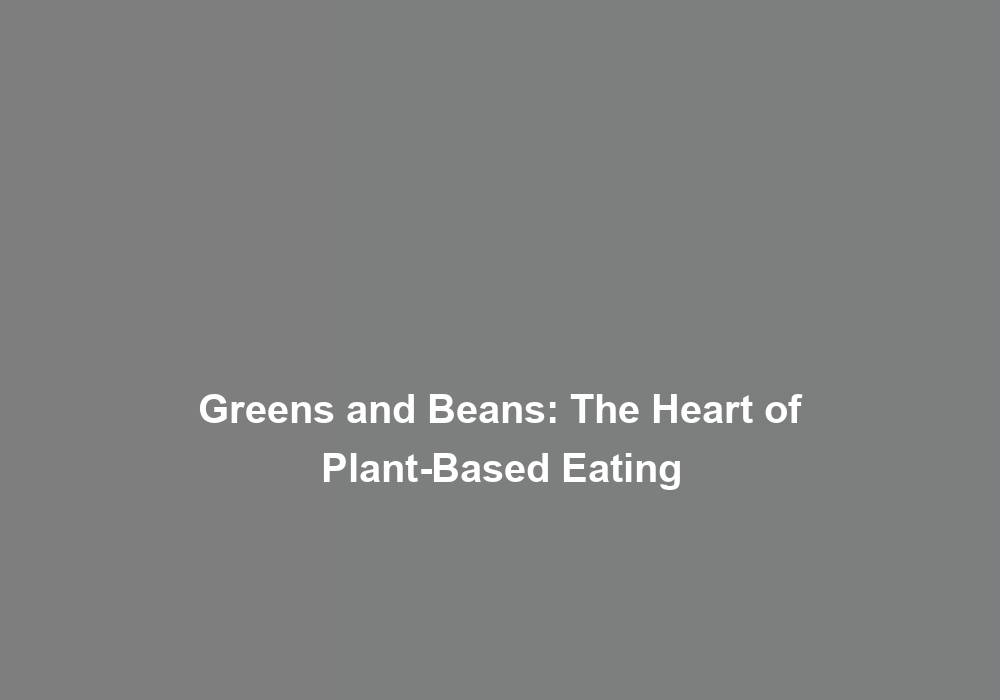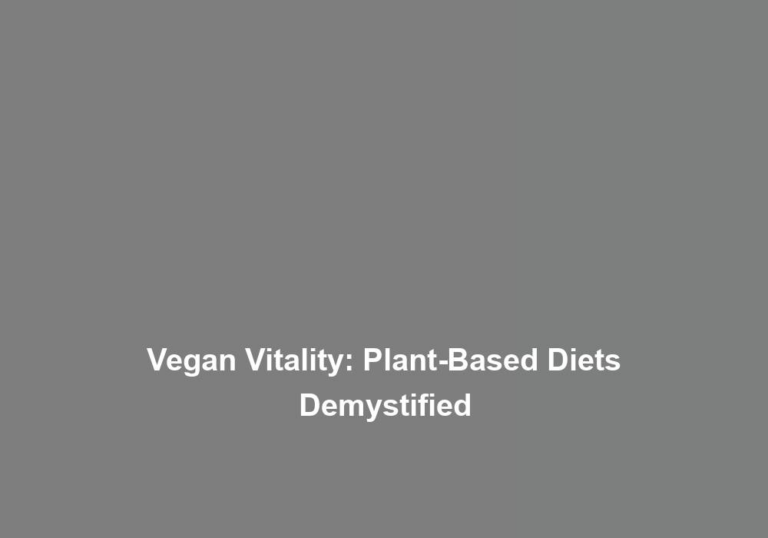Greens and Beans: The Heart of Plant-Based Eating
You may think that plant-based eating is all about salads and smoothies, but thereG??s a key pair of ingredients that are often overlooked: greens and beans. These humble, yet powerful foods form the foundation of a nutritious and sustainable diet. As you explore the nutritional benefits and versatility of greens and beans, youG??ll discover how they can become the heart of your plant-based meals. But what exactly makes them so essential? Keep reading to uncover the surprising impact that greens and beans can have on your health and the environment.
Nutritional Benefits of Greens and Beans
Adding greens and beans to your diet can provide a wealth of essential nutrients and health benefits. Both are rich in fiber, vitamins, minerals, and antioxidants. Greens such as spinach, kale, and collard greens are excellent sources of vitamins A, C, and K, as well as folate and potassium. On the other hand, beans like black beans, chickpeas, and lentils are packed with plant-based protein, fiber, iron, and zinc. These nutrients are essential for your overall health and well-being.
When it comes to nutrient absorption, greens and beans play a crucial role. The fiber in these foods not only aids in digestion but also promotes the growth of beneficial gut bacteria, which can enhance nutrient absorption. Additionally, the high levels of vitamin C in greens and the presence of certain compounds in beans can help increase the absorption of non-heme iron, which is the type of iron found in plant-based foods. This is particularly important for individuals following a vegetarian or vegan diet.
Furthermore, the plant-based protein found in beans is an excellent alternative to meat. Not only is it lower in saturated fat, but it also provides a wide range of essential amino acids necessary for muscle growth and repair. Incorporating a variety of greens and beans into your diet can help ensure that you are meeting your daily protein needs while reaping the numerous health benefits associated with plant-based eating.
Incorporating Greens and Beans Into Your Meals
To enhance the nutritional value of your meals, consider incorporating a diverse selection of greens and beans into your daily diet. Meal planning becomes more enjoyable and nutritious when you include an array of greens such as spinach, kale, and Swiss chard, along with beans like black beans, chickpeas, and lentils. These ingredients are not only rich in essential nutrients but also versatile, making it easy to add them to your favorite dishes.
When meal planning, think about flavor combinations that complement each other. For instance, pairing earthy greens like kale with hearty beans such as black beans can create a satisfying and nutrient-dense meal. Consider adding spinach to a chickpea curry for a vibrant pop of color and an extra dose of vitamins. Mixing greens and beans into salads, soups, and stir-fries can add both texture and nutritional value.
When it comes to flavor combinations, donG??t be afraid to experiment. For example, try incorporating cannellini beans into a pesto pasta dish for added creaminess and protein. Additionally, combining beans and greens with flavorful herbs and spices like garlic, cumin, or lemon can elevate the taste profile of your meals.
Incorporating greens and beans into your meals not only boosts their nutritional content but also introduces a variety of textures and flavors to your diet. By being mindful of meal planning and experimenting with different flavor combinations, you can create delicious and satisfying plant-based meals that nourish your body and soul.
Health Impacts of Greens and Beans
Eating a diet rich in greens and beans has numerous health benefits. These plant-based foods are packed with essential nutrients like vitamins, minerals, and fiber, which can support overall well-being. Research suggests that incorporating greens and beans into your meals may help prevent chronic diseases, improve digestive health, and contribute to a balanced diet.
Nutritional Benefits
Nutrient-dense greens and beans offer a wide array of health benefits, making them essential components of a balanced plant-based diet. Greens like spinach, kale, and collard greens are rich in vitamins A, C, and K, as well as minerals like iron and calcium. Beans, including black beans, chickpeas, and lentils, provide ample protein, fiber, and essential nutrients such as folate and magnesium. These nutrients are vital for various bodily functions, including energy production, immune system support, and bone health. Additionally, the combination of greens and beans enhances nutrient absorption due to their complementary nutrient profiles. When meal planning, aim to include a variety of greens and beans to maximize their nutritional benefits and promote overall well-being. By incorporating these wholesome foods into your meals, you can significantly improve your health and vitality.
Disease Prevention
Incorporating a variety of greens and beans into your diet can significantly contribute to disease prevention and overall health due to their rich array of essential nutrients and health-promoting properties. Dietary choices play a crucial role in preventing illness, and the regular consumption of greens and beans can have a profound impact on your well-being. Greens such as kale, spinach, and collard greens are rich in vitamins, minerals, and antioxidants that support a healthy immune system and reduce the risk of chronic diseases. Similarly, beans like black beans, chickpeas, and lentils provide a significant amount of fiber, protein, and various micronutrients that contribute to heart health and weight management. By incorporating these nutrient-dense foods into your meals, you can proactively support your health and well-being.
| Greens | Health Benefits | Emotional Response |
|---|---|---|
| Kale | High in antioxidants and vitamins | Nourishing |
| Spinach | Rich in iron and essential nutrients | Vitality |
| Collard Greens | Supports digestive health | Grounding |
Digestive Health
To continue our exploration of the health benefits of greens and beans, letG??s now turn our attention to the impact of these nutrient-rich foods on digestive health. Making greens and beans a staple in your diet can significantly benefit your digestive system. HereG??s why:
- Gut Microbiota: Greens and beans are rich in fiber, which nourishes the good bacteria in your gut, promoting a healthy microbiota.
- Fiber Intake: These foods provide essential dietary fiber, aiding digestion and preventing constipation.
- Plant-Based Enzymes: They contain plant-based enzymes that support the breakdown of food, easing the digestive process.
- Digestive Enzymes: Consuming greens and beans can also stimulate the production of digestive enzymes in your body, promoting efficient nutrient absorption and overall digestive health.
Incorporating greens and beans into your diet can contribute to a healthier, more vibrant digestive system.
Versatility of Greens and Beans in Cooking
Exploring the versatility of greens and beans in cooking opens up a world of culinary creativity and nutritional benefits. Greens such as spinach, kale, and Swiss chard, along with beans like chickpeas, black beans, and lentils, can be prepared in numerous ways to create delicious and satisfying plant-based meals. Understanding different cooking techniques and flavor pairings can help you make the most of these ingredients.
When it comes to cooking techniques, greens and beans can be steamed, saut+?ed, roasted, or even blended into soups and stews. Each method brings out unique flavors and textures, adding depth to your dishes. For instance, saut+?ing greens with garlic and olive oil can enhance their natural earthy flavors, while roasting beans with a sprinkle of cumin and paprika can create a delightful smokiness.
Pairing greens and beans with complementary flavors is essential for creating well-balanced and appetizing dishes. Consider combining beans with acidic ingredients like tomatoes or vinegar to cut through their richness, or adding a touch of sweetness from caramelized onions to balance the slight bitterness of certain greens.
Below is a table summarizing some cooking techniques and flavor pairings to inspire your plant-based culinary adventures:
| Cooking Techniques | Flavor Pairings |
|---|---|
| Steaming | Lemon, Garlic |
| Saut+?ing | Olive Oil, Herbs |
| Roasting | Cumin, Paprika |
| Blending | Coconut Milk, Curry |
| Simmering | Onions, Tomatoes |
Sustainability and Environmental Benefits
Considering the growing concern for environmental impact, understanding the sustainability and environmental benefits of plant-based eating is crucial for making informed dietary choices. Embracing a plant-based diet not only offers a wide array of health benefits but also has a significant positive impact on the environment. Here are four key reasons why plant-based eating contributes to sustainable living:
-
Reduced Carbon Footprint: Plant-based foods generally have a lower environmental impact than animal-based products. By choosing a diet rich in fruits, vegetables, legumes, and whole grains, you can significantly reduce your carbon footprint, as these foods require fewer natural resources and produce fewer greenhouse gas emissions compared to animal products.
-
Conservation of Water Resources: Plant-based diets require less water to produce when compared to animal-based diets. By opting for plant-based meals, you can contribute to the conservation of water resources, which is crucial for sustainable living, especially in regions facing water scarcity.
-
Preservation of Biodiversity: Plant-based eating helps in preserving biodiversity. Large-scale animal agriculture is a significant driver of deforestation and habitat destruction. By choosing plant-based foods, you can help mitigate these environmental impacts and contribute to the preservation of wildlife and ecosystems.
-
Reduction of Pollution: Plant-based diets contribute to the reduction of environmental pollution. The production of animal-based foods often leads to water and air pollution through the release of agricultural chemicals and waste. By consuming plant-based foods, you can play a part in minimizing pollution and promoting a cleaner environment.
Tips for Maximizing Greens and Beans in Your Diet
To maximize greens and beans in your diet, consider incorporating nutrient-rich greens like spinach, kale, and Swiss chard into your meals to boost your intake of vitamins, minerals, and fiber. Experiment with versatile bean recipes such as black bean tacos, chickpea salads, and lentil soups to add plant-based protein and variety to your diet. By combining greens and beans, you can create balanced meal options that are not only nutritious but also delicious and satisfying.
Nutrient-Rich Greens
Maximize the nutritional value of your diet by incorporating nutrient-rich greens and beans in your meals. When it comes to leafy greens and beans, here are four tips to help you make the most of these superfoods:
- Diversify your greens: Incorporate a variety of leafy greens such as spinach, kale, and Swiss chard into your meals to benefit from a wide range of nutrients.
- Pair greens with plant-based protein: Combine leafy greens with beans, lentils, or quinoa to create protein-rich and fiber-filled meals.
- Opt for raw or lightly cooked greens: Retain the maximum nutrients by consuming your leafy greens in their raw form or lightly cooking them to preserve their nutritional value.
- Use greens as a base: Swap out traditional grains for greens like kale or collard greens as the base for your meals to increase your intake of essential vitamins and minerals.
Versatile Bean Recipes
To further enhance the nutritional value of your meals, incorporating versatile bean recipes alongside your nutrient-rich greens can add a wealth of flavor, protein, and fiber to your plant-based diet. Bean salads are a quick and easy way to enjoy the benefits of beans, combining them with fresh greens, herbs, and a flavorful vinaigrette. Bean soups are another hearty and satisfying option, allowing you to incorporate a variety of greens like kale or spinach for added nutrients. For a refreshing twist, consider adding beans to your green smoothies for a creamy texture and an extra boost of plant-based protein. Additionally, greens stir fry with beans is a delicious and nutritious way to create a balanced meal. These versatile bean recipes not only provide essential nutrients but also offer delicious flavors to make your plant-based eating enjoyable and fulfilling.
Balanced Meal Options
For a well-rounded plant-based diet rich in essential nutrients, consider incorporating a variety of greens and beans into your meals to maximize both flavor and nutritional benefits. When planning your meals, keep in mind these tips for maximizing greens and beans in your diet:
- Meal planning: Plan your meals ahead of time to ensure you include a variety of greens and beans in your diet.
- Protein sources: Incorporate protein-rich beans such as chickpeas, black beans, and lentils into your meals to meet your protein needs.
- Balance your plate: Aim to fill half of your plate with nutrient-dense greens like kale, spinach, or collard greens, and the other half with beans or legumes for a balanced meal.
- Variety is key: Experiment with different types of beans and greens to keep your meals exciting and packed with diverse nutrients.
Conclusion
So, next time youG??re looking for a wholesome, nutritious, and sustainable option for your meals, consider incorporating more greens and beans into your diet. These powerhouses of plant-based eating offer a wealth of health benefits, are incredibly versatile in cooking, and have a positive impact on the environment. With a few simple tips, you can easily maximize the benefits of greens and beans in your daily meals. Happy eating!







